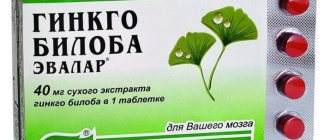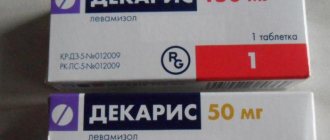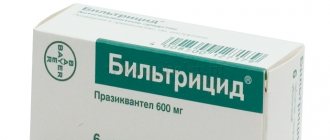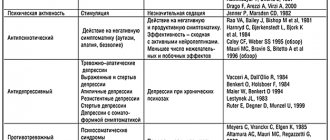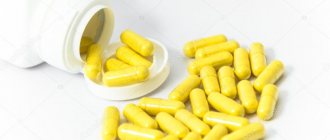Release form
These are white or yellowish tablets. Their shape, the presence of chamfers and scratches depend on the dosage. Teturama tablets are available with different masses of the active substance:
- 100 mg,
- 150 mg,
- 200,
- 250 mg.
They are packaged in blisters, glass jars, and plastic bottles. In addition to the active component, the tablets contain excipients necessary for forming and storing the product:
- calcium stearate,
- silica,
- potato starch.
As auxiliary ingredients, the most neutral compounds are used that do not cause allergies and do not interact with the molecules of the product.
Operating principle of Teturam
When using the product, it reduces the activity of a special substance - acetaldehyde dehydrogenase. Because of this, ethanol cannot be absorbed normally, and when it enters the blood, it decomposes to form a large amount of acetaldehyde. This leads to the development of symptoms of acute poisoning:
- severe nausea and frequent vomiting,
- hypotension, rapid pulse,
- severe redness of the face,
- feeling hot and generally feeling unwell.
Thus, during treatment, drinking alcohol becomes impossible.
Description of the drug TETURAM
You should avoid taking alcoholic beverages and ethanol-containing medications during treatment with disulfiram to avoid the development of reactions caused by the disulfiram-ethanol association.
When used simultaneously, disulfiram increases the risk of behavioral and coordination disorders.
With the simultaneous use of disulfiram with nitroimidazole derivatives (metronidazole, ornidazole, secnidazole, tinidazole), acute delirium and confusion are possible.
With simultaneous use of disulfiram with phenytoin, a significant and rapid increase in plasma concentrations of phenytoin occurs, leading to an increased risk of toxic effects (disulfiram inhibits the metabolism of phenytoin).
With the simultaneous use of disulfiram and hepatotoxic drugs, liver damage is possible.
With simultaneous use of disulfiram with warfarin and other indirect anticoagulants, the anticoagulant effect is enhanced and the risk of bleeding increases (decreased metabolism of warfarin in the liver).
Disulfiram reduces the metabolism of theophylline. When used simultaneously, dose adjustment of theophylline is necessary.
With simultaneous use, the plasma concentration of diazepam and chlordiazepoxide increases, in some cases accompanied by dizziness. Under the influence of diazepam, the intensity of the disulfiram-ethanol reaction may decrease. A case of increased toxicity of temazepam has been described.
When disulfiram is used simultaneously with tricyclic antidepressants, phenothiazine derivatives, and MAO inhibitors, there is a risk of developing serious adverse reactions associated with drug interactions.
Disulfiram inhibits liver enzymes, therefore, with simultaneous use of drugs metabolized in the liver, their metabolism may be disrupted.
A case of the development of mania in a patient taking disulfiram and buspirone is described.
With simultaneous use, the clearance of desipramine and imipramine from the body decreases.
When used simultaneously with amitriptyline, it is possible to enhance the therapeutic effect of disulfiram, but it is also possible to enhance the toxic effect of amitriptyline on the central nervous system.
When used simultaneously with isoniazid, cases of dizziness and depression have been described; with caffeine - the excretion of caffeine from the body decreases; with metronidazole - acute psychosis and confusion develop; with omeprazole - a case of the development of impaired consciousness and catatonia is described.
When used concomitantly with perphenazine, the development of psychotic symptoms cannot be excluded.
When used concomitantly, disulfiram inhibits the metabolism and excretion of rifampicin.
When used simultaneously with phenazone, T1/2 of phenazone increases; with phenytoin - the effects of phenytoin are enhanced due to an increase in its concentration in the blood plasma, toxic reactions develop.
When used simultaneously with chlorzoxazone, the concentration of chlorzoxazone in the blood plasma increases; with chlorpromazine - increased arterial hypotension is possible.
Metabolism Teturama
The substance is absorbed in the digestive tract almost completely, absorbed from 70 to 90%. Disulfiram is a fat-soluble substance, so it can accumulate in fat-storing tissues. The main chemical transformations take place in the liver, where the drug exerts its pharmacological effect. Although its maximum concentration in the blood is recorded 4 hours after drinking the tablet, a pronounced effect occurs on the 3rd day of taking the drug. Metabolites of the drug are excreted in urine and feces, the half-life is about 10 hours. But due to the ability to be deposited in tissues, the effect of the tablets is observed for about 1-2 weeks after stopping use.
Indications for use
Teturam can only be purchased with a doctor’s prescription, which is issued after examination and determination of the entire complex of therapy. The drug is used for:
- treatment of alcoholism of any stage;
- preventing breakdowns after completion of the main course of therapy,
- relief of symptoms of poisoning with small doses of nickel (specific, often occupational intoxication), which is relatively rare in clinical practice.
Encoding with Teturam is possible only after the person’s informed consent. In this case, the doctor is obliged to tell in an accessible form not only the expected effect of the drug, but also familiarize the person with the list of contraindications and possible side effects.
Treatment of alcoholism with Teturam
Dosage. The most commonly used tablets contain 150 mg of disulfiram. Teturam is also available with 100 and 200 mg of active substance. The dosage of the drug should be as precise as possible. It is calculated by a narcologist, taking into account:
- the patient’s health status (data is collected during examination, using laboratory diagnostics, during a preliminary consultation);
- stage of alcohol dependence, severity of craving for alcohol, severity of withdrawal syndrome;
- weight and age;
- features of the prescribed auxiliary therapy, treatment plan.
Exceeding the optimal dosage increases the toxic effect on the body. This effect is especially pronounced for the liver (additional use of hepatoprotectors is recommended). If the dosage is insufficient, the encoding effect will be weakened.
Order alcoholism coding
Experienced doctors and narcologists. In hospital or at home. 24-hour service in Moscow and the region. Professional, anonymous, safe.
Control of contraindications. Teturam should not be used if:
- renal, liver failure;
- oncology;
- severe or chronic diseases, pathologies of the respiratory system. The drug is incompatible with isoniazid and other anti-tuberculosis drugs;
- infectious lesions of the central nervous system;
- pathologies of the cardiovascular system;
- bleeding in the intestines, stomach;
- mental disorders.
Teturam is used with caution in old age (over 60 years), with exacerbations of peptic ulcer disease, the presence of residual effects after a stroke, etc. The decision on the possibility of using the drug for coding is made by the doctor at the NarcoDoc clinic.
Detoxification. Detoxification and rehabilitation therapy is carried out before taking Teturam to make the encoding safe. If the patient is unable to abstain from drinking alcohol before starting treatment, and traces of ethyl alcohol remain in the blood, severe side effects will occur immediately after taking the first tablet. The period of sobriety is from 3 days.
Treatment. Teturam take 1-3 tablets per day. It is advisable that the drug be taken under the supervision of a narcologist, in a 24-hour or day hospital setting. Outpatient treatment of alcoholism at home is possible, but in this case the patient must regularly visit a narcologist. The course is from 4-6 weeks.
Control of the result. For control, the “provocation” method is used. The procedure is carried out only under the supervision of a narcologist, in a medical center. On days 7-10 of the course, a minimum dose of alcohol is given. After using it, a rejection reaction should occur with the appearance of side effects. The narcologist assesses the severity of intoxication and, if necessary, quickly relieves its symptoms. Provocation with alcohol is needed to assess the effectiveness of treatment and adjust the dosage. It is also performed in order to form a reflex aversion to alcohol in the patient.
After completing the course of treatment with Teturam, the patient, together with the narcologist, decides on further therapy. He can independently abstain from drinking alcohol, use long-term treatment for alcoholism (injections or implant), and continue treatment with naltrexone-based drugs.
Medical doctors recommend combining drug treatment for alcohol addiction with psychotherapy and adequate rehabilitation: this will help increase motivation to overcome addiction, control the psychological state, and quickly restore social connections.
Contraindications
Since the drug is potent, and the consequences after drinking alcohol are quite severe, the list of contraindications for coding with Teturam includes:
- open form of tuberculosis, pulmonary hemorrhage;
- heart disease in the acute stage - angina pectoris, heart attack or a high risk of its development, hypertension of degree 2 and higher, compensated and decompensated heart failure;
- vascular diseases - atherosclerosis of the arteries of the heart and brain, aneurysm of the aorta and other vessels;
- peptic ulcer of the stomach or intestines in the acute stage;
- bleeding from any part of the digestive system;
- hepatic cell failure – in acute hepatitis, fibrosis or cirrhosis;
- mental and nervous disorders, including epilepsy;
- meningitis, encephalitis of any etiology;
- malignant tumors of any location;
- glaucoma – increased pressure in the eyeball;
- state of intoxication or acute alcohol poisoning.
Also, the drug is not prescribed to pregnant and lactating women, as well as to adolescents.
Rules of application
Due to such a large list of contraindications, a full medical examination is carried out before prescribing the drug. It is necessary, since chronic alcoholism very often develops various pathologies. Before encoding with Teturam, you need to wait until all manifestations of withdrawal symptoms have completely disappeared. If a person has taken any psychotropic drugs (neuroleptics, antidepressants, sleeping pills or tranquilizers), then they are canceled 2-3 days before disulfiram is prescribed. The standard Teturam encoding course consists of the following stages:
- They give 150-500 mg. means twice a day,
- After 7-10 days of use, an alcohol test is performed. To do this, the patient orally takes 30 ml of alcohol of 40% concentration. For mild negative effects, another 10-20 ml may be given.
- After 2 days, a second test is carried out. To carry it out, a person is temporarily admitted to the hospital in order to quickly provide assistance in case of a severe reaction to ethanol.
- The last third test is done after another 5 days. By this time the patient has already been discharged.
Based on the test results, the doctor may increase or decrease the dosage of the drug. While treatment of alcoholism with Teturam continues, the patient should not drive a car or carry out any activity that requires quick reaction and attention. To prevent breakdowns, maintenance therapy may be prescribed. For this, Teturam is taken in a dose of 150-200 mg. (1 tablet) per day. With awareness and compliance with medical recommendations, this helps a person to abstain from alcohol for a long time, until he finally stops feeling the craving for vodka.
Application of Teturama
Teturam is used for coding against alcohol dependence. The principle of action is as follows: the liver contains a special enzyme - acetaldehyde dehydrogenase. The name, of course, can be tongue-tied, but the point of the enzyme is that it removes acetaldehyde, the most dangerous component of alcohol. It is thanks to this enzyme that alcohol is absorbed by the body, successfully processed and excreted.
The use of Teturam is precisely based on blocking this enzyme. Yes, when taking Teturam, the body will not be able to process alcohol. What will happen with the next portion of alcohol? Severe alcohol poisoning will occur, the patient will begin to feel sick, vomiting, fever, and blood will rush to the face. If a person tries to drink even more, partial loss of vision and hearing and difficulty breathing may occur. In isolated cases there is a risk of death, but this is only possible with a large portion of alcohol.
Undoubtedly, the Teturam instructions immediately make us understand that such coding is quite radical and leads to very unpleasant sensations for the body. However, it is precisely this option that quickly changes the attitude towards alcohol. When, instead of pleasant intoxication, a person receives a sea of painful sensations similar to a severe hangover, he develops an aversion to alcohol. Adding to the effect is the fear that the reaction could be even worse. As a result, the drug works great, which is confirmed by numerous positive reviews of Teturam.
In the case of this drug, the most popular form is Teturam tablets, they are available at 150 mg each for daily oral administration. There is another option for Teturam coding - binder, but it is not currently used. During stitching, the doctor placed 8 100 mg tablets around the incision in a cross pattern. However, today Teturam tablets are used for oral administration, and they show excellent results.
Side effects of Teturam
They are not found in all patients. Tell your doctor if:
- metallic taste on the tongue,
- memory impairment,
- increased frequency of headache episodes,
- weight loss,
- the appearance of nervous and mental disorders, in particular cases of disorientation,
- allergies in the form of a rash.
If a patient, during treatment with Teturam, loses his temper and drinks alcohol-containing drinks, he increases the risk of developing:
- heart attack,
- an attack of arrhythmia or angina pectoris,
- a sharp decrease in pressure with the development of shock,
- cerebral hemorrhages,
- cerebral edema,
- respiratory failure.
If more than 50 ml is drunk. vodka or other strong drink, convulsions and heart failure may occur. If a breakdown occurs, immediate hospitalization is needed. Only in a hospital setting will it be possible to quickly detoxify and cope with breathing problems. Taking Teturam is certainly associated with some risks, but side effects are probable, and not mandatory, consequences of treatment. And with continued alcoholism, concomitant diseases will certainly develop and sooner or later lead to death.
The use of Teturam has many limitations
Firstly, this coding option has many contraindications. Teturam tablets should not be used in case of hypersensitivity to the components of the drug, thyrotoxicosis, tuberculosis, kidney disease, diabetes mellitus, pregnancy, lactation, glaucoma, epilepsy and many other diseases.
Secondly, coding using pills will only work when the patient has a negligible risk of relapse, when he himself wants to be cured and does everything for this, when he is confident that he can take pills every day without skipping. Only in this case will coding bring a positive result. If there is a risk of future breakdowns, it is better to choose injections or stitching.
Literature:
- Methods of psychotherapy for drug addicted patients / I. D. Darensky. — Moscow: Sputnik+ Company, 2007. — 414 p.
- Lectures on pharmacology for doctors and pharmacists: a textbook for medical universities / A. I. Vengerovsky. — [3rd ed., revised. and additional]. - Moscow: Physics and Mathematics Literature, 2007. - 702 p.
- A short reference book on psychopharmacology, pharmacotherapy and mental pathology / Kozlovsky, Vladimir Leonidovich / St. Petersburg: SpetsLit, 2015.
The text was checked by expert doctors: Head of the socio-psychological service of the Alkoklinik MC, psychologist Yu.P. Baranova, L.A. Serova, a psychiatrist-narcologist.
CAN'T FIND THE ANSWER?
Consult a specialist
Or call: +7 (495) 798-30-80
Call! We work around the clock!

